
Ahnfeltiopsis linearis
Flat-tipped Forked Seaweed
Fishboat Bay, Juan de Fuca Strait, Shirley, British Columbia, Canada
15 November 2020
Observed at 7:45pm PST
Low Tide 0.3 feet at 20:06 PST (measured at Sheringham Point Tidal Station)
Weather: Mostly cloudy & clearing, occasional light mist, wind variable 5 km/hour, sea rippled with a low SE swell, temperature 8˚C, relative humidity 85%.
Phase of Moon: Waxing Crescent (approx. 23 hours into this phase at time of observation); (Previous Phase, New Moon, 14 November 2020 at 9:07pm PST: Next Phase, First Quarter, 21 November 2020 at 8:45pm PST.)
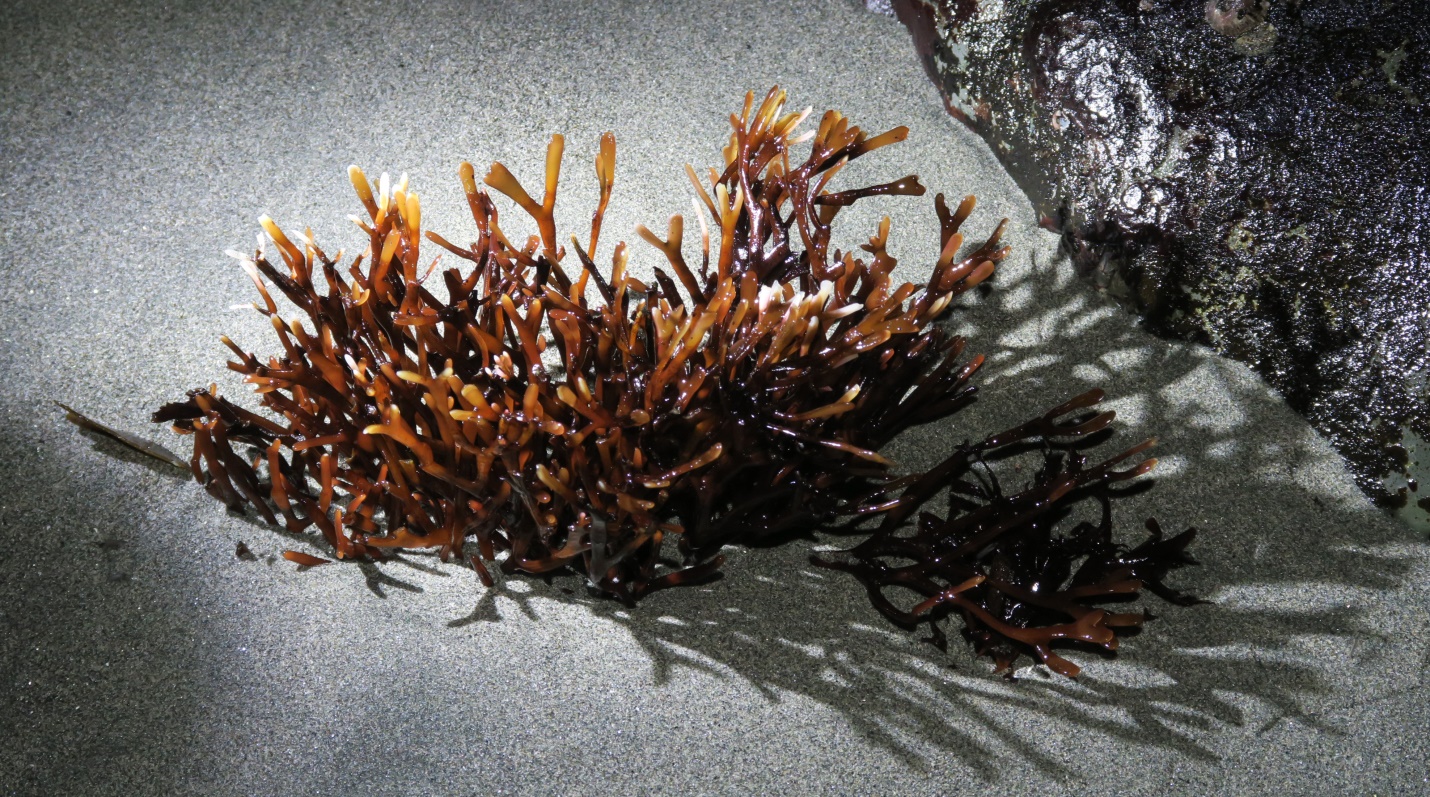
Figure 1: Ahnfeltiopsis linearis, Flat-tipped Forked Seaweed in its sandy habitat adjacent to bedrock (lit by headlamp); Fishboat Bay, Juan de Fuca Strait, BC, Canada. November 15, 2020. Photo ID: 27112 ©Seaweedwhisperings.com
In situ observations:
We interacted with/observed this seaweed in the high intertidal zone near wave-smoothed granite bedrock protrusions. The beach surrounding the bedrock is composed of a wide expanse of weathered granite sand. Observations were done in situ with the living seaweed during a nighttime low tide.
Person 1:
Visually this seaweed’s appearance reminded me of deer antlers, deer ears, Mickey Mouse ears and hands waving.
Two toned olive coloration, pale towards tips.
I like playing with the shadows cast on the sand by this plant as I move my headlamp beam at different angles.
Looks tough but friendly.
Base of the seaweed is securely tucked beneath the sand with what looks like only necks, faces and ears protruding above (the sand).
Individual forked thalli of the plant grow in a single flat plane; the group of thalli that comprise this one plant (cluster) are oriented in all different directions.
Looks sort of like an “afro” hairdo.
Differently oriented stems disperse the energy of the sea?
From a distance I expected the texture of this seaweed to be somewhat rough, but discovered that the tips, in particular, feel smooth.
Growth pattern is neatly dichotomously twice branched towards tips, but this pattern is far less organized toward base.
Stem breaks crisply.
Very crisp, celery-like to bite into.
Slight cucumber flavor.
“Flat-tipped Forked Seaweed” – good description of its above sand habit.
“Ahnfeltiopsis” – lovely lilting sounding name.
“Linearis” – in my mind this doesn’t match its disorderly appearance.
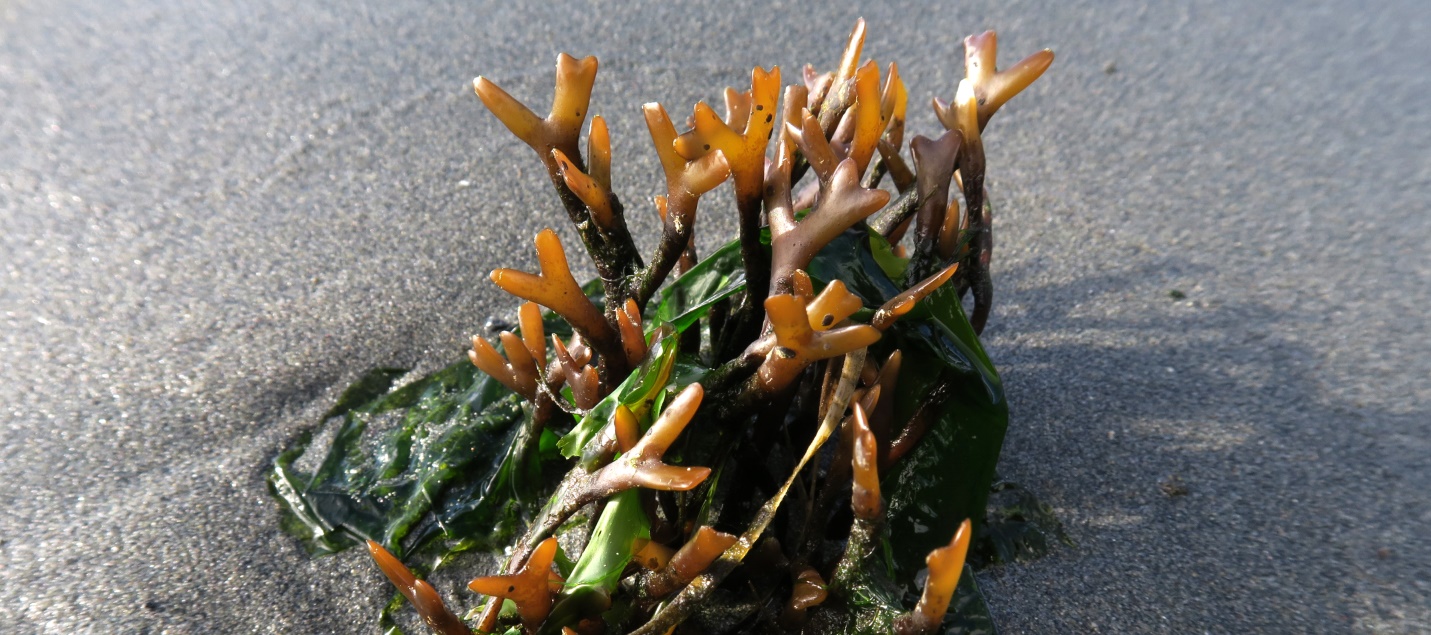
Figure 2: Ahnfeltiopsis linearis, Flat-tipped Forked Seaweed – stem tips lit by early morning sunlight, with strands of green Ulva draped amidst the thalli; Fishboat Bay, Juan de Fuca Strait, BC, Canada. August 18, 2020. Photo ID: 27113 ©Seaweedwhisperings.com
Person 2:
Distinctive.
Standing erect.
Rising out of the sand.
Forked.
Two-toned brown.
Caramel colored tips, with darker chocolate brown stems (and a third off-white tone is visible on some bleached (unhealthy) tips).
Stems are rounder closer to the sand – and they flatten and broaden out at the tips.
Tough.
Stems feel tough.
Surface of stems looks like fine sand-stone.
Tips look and feel smoother, like thick cartilage.
No wonder! You’re polished by sand with every wave; except of course when you’re completely buried, then all is calm for a while in that regard.
But how can you grow when light cannot reach you through the sand that covers you?
So you are sometimes growing and also abraded constantly, sometimes you are dormant and peacefully “held” in a sandy embrace.
I believe you can still ‘breathe’ seawater through the sand once submerged.
You live comfortably with the changes of tides, winds and currents.
Forked shape – the angle is a pleasing one, approximately 33 degrees. This is the angle of rest of a cinder cone – a pile of other mineral matter that rests in a cone shape. Maybe that is somehow compatible with the sand your forks live in?
The look of this seaweed reminds me of a branching coral, and some of the forked tips look like the ‘wishbone’ of a chicken (fusion of the clavicles just above the sternum).
I break a stem; it is solid.
I need to cut the stem away with my nail, as bending it almost double it doesn’t break it.
Strong, tough, yet flexible.
No taste.
No smell.
Reach up, fork out, fork out again, and at the tip of each fork an indentation suggestive of yet another fork.
Forking growth, this is a simple branch pattern – a more complicated one may be too vulnerable to tangle with shifting sands.
“Flat-tipped Forked Seaweed” – unimaginative name but very apt description.
“Ahnfeltiopsis” – someone’s name, “Ahnfelt” plus “iopsis” – the suffix gives it a lighter sound and imparts to me a sense of “self-involvement”.
“Linearis” – linear, a leads to b, leads to c, and so on. I can see this in the forking pattern of growth – it’s like the flow chart of a computer program, linear, this or that, and then the path forward can flow.
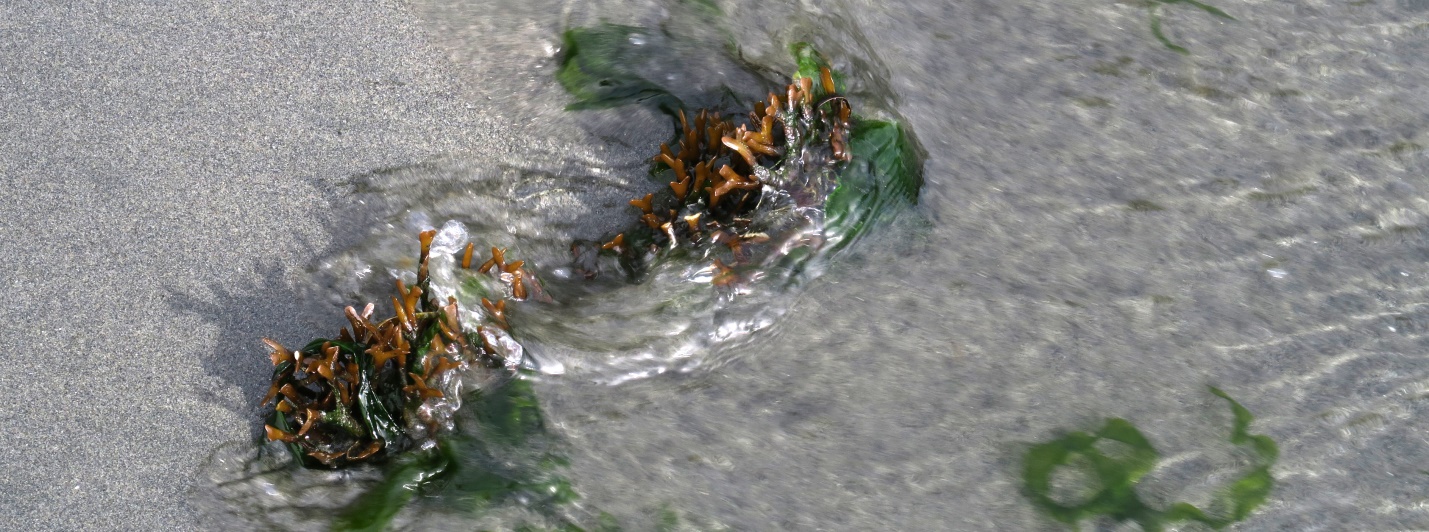
Figure 3: Ahnfeltiopsis linearis, a cluster of fork-tipped stems meeting the surf; Ulva linza and Ulva lactuca tangled around; Fishboat Bay, Juan de Fuca Strait, BC, Canada. August 18, 2020. Photo ID: 27114 ©Seaweedwhisperings.com
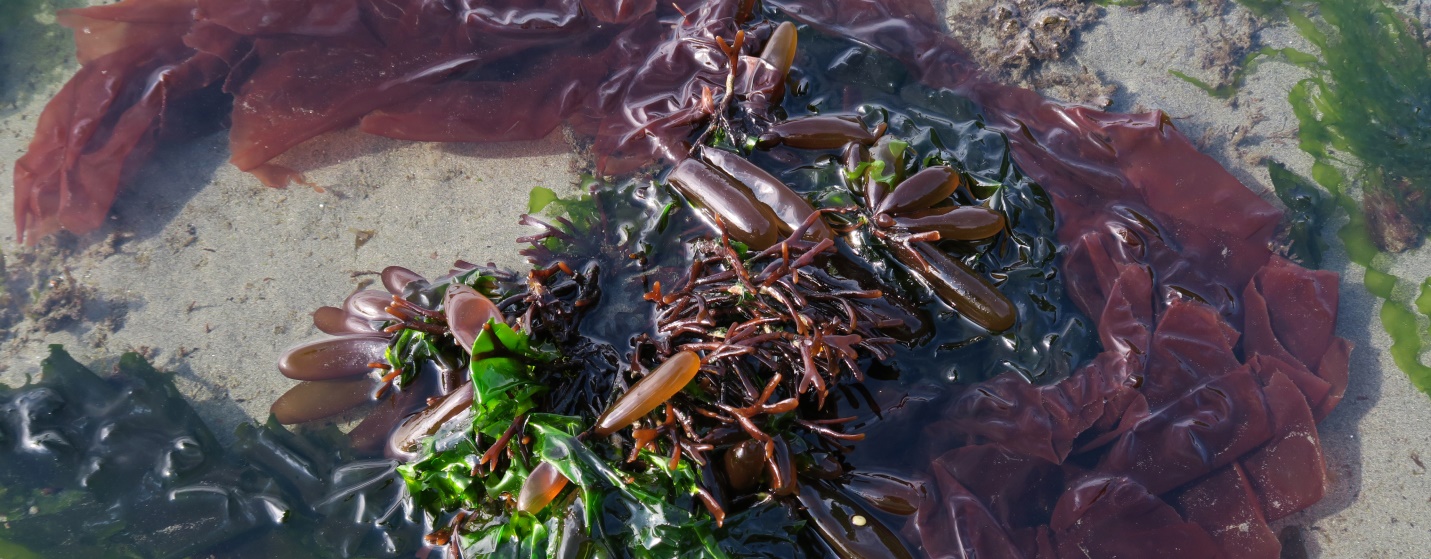
Figure 4: Ahnfeltiopsis linearis is the anchor for all these seaweeds – look at the center of the photo and you will see the flat-tipped forked stems and growing as annuals are Halosaccion glandiforme, Ulva lactuca, Ulva linza, and Wildemania amplissima; Fishboat Bay, Juan de Fuca Strait, BC, Canada. July 6, 2020. Photo ID: 27115 ©Seaweedwhisperings.com
Further Observations & Impressions:
Person 1:
Showy exterior hides what is really going on.
Happy to be alone or in its small group. You seem independent.
Surface is tough – “Give me all you’ve got…, I can handle it”.
Playful.
Basic values fixed and rigid with a façade of sophistication.
I had the sense that my documentation for this whispering was highly disorganized and I felt the desire to make order out of it, but this felt unsuccessful.
Person 2 abruptly got up and walked away from the seaweed; she was looking for another plant to work with that might be situated in a more comfortable location for observation. Seeking/needing a more comfortable position struck me as a strong contrast to Ahnfeltiopsis which feels just fine where it is.
Person 2 was also somewhat uncomfortable with the environment as a whole, specifically concerned about surf action and incoming tide. I felt there was no need for this concern.
Then I thought, “Am I missing something?”
Is there confusion in this seaweed’s energy?
Or, deception?
No…, this is all about the seaweed – I was in touch with its own total comfort with tide and wave action; Ahnfeltiopsis even welcomes this.
Person 2 got up, stood with arms raised up and out forming a large “V”. This interested me, so I tried it too. My arms felt very stiff and sore to move into that “V” position.
Wondering if there is a double life to this seaweed – one above sand and the other below…?
The life-below-sand of this seaweed is so well concealed that almost nobody knows it is there, thus no one can explore or interact with it.
Person 2:
After a big fall storm – high winds, much rain, we returned to Fishboat Bay for a very low tide, in the dark of night. The sands had shifted and a whole new Ahnfeltiopsis linearis plant was exposed to the night sky. We’ve not seen it here in this particular spot before, in fact, we’ve probably walked on the sand immediately above it, but we have seen its ‘cousins’ elsewhere on the beach.
Forked growth - grow upward, try branching out, then fork again.
Always more than one option.
Are you balancing your reach – with opposing effort, one to one?
Are you like a tuning fork?
Testing for perfect pitch?
All your stems seem harmonious with each other, so that if you are pushed by the tide you’ll not clash but bend and lie softly adjacent to each other.
How deep down in the sand do you grow?
I think quite far.
I don’t want to dig to find your anchor and possibly harm you – so I’ll just have to wonder.
Do you wonder, too?
Wonder which fork?
Enjoy the “wonder” of life?
Tough.
Handsome.
Sleek.
Attractive coloration.
Your flattened tips sense more, don’t they?
Is it here you breathe and smell and taste and touch?
Is it here where you are really engaging?
Reaching out and up, like a symbol of your will.
I feel somewhat on edge; like something could come up, possibly a rogue wave – being alert for the unexpected has me feeling uncomfortable. Being here in the dark of early night with no moon, my dominant sense, sight, is limited to what my headlamp illuminates – this limitation is unnerving; I can’t settle and be totally at ease.
Your will, it is strong.
You strive.
And endure; yes, endure very well.
But for all your admirable will and your handsome form, at times you are completely removed from sight – not by your choice, nor at a time you might choose.
Or is this your strategy…?
To go underground?
To pause any visible efforts and simply disappear?
While you are ‘disappeared’ do you plot and plan and dream?
Or do you slumber deeply, patiently, until the light touches you again?
I don’t think you fear being underground at all – this is your strength. To accept an “on” life, and then an “off” life.
I feel stiff from sitting on the sand next to you. This stiffness is notable and will not be ignored. I kept shifting positions, even walked away to look for a possible new Ahnfeltiopsis plant where it might be more comfortable to sit.
One could say that you’re stiff, Ahnfeltiopsis!
Oh, Person 1 just did.
That is true.
You’re not floppy and spineless and flattened like many of your algae neighbours. You don’t wave and undulate and swish yourself around in the surf.
No, you’re stiff, erect, tough, enduring.
Aha! I don’t want to sit. I want to stand – that feels so much better.
You “stand” too – you don’t sit.
I put my arms out, raised and forked like you.
I put my awareness to my body, my legs and torso, the base of me, is standing straight. My arms are raised above my head in a “V”. I imagine the surf washing over me and the type of gentle movements possible for my forked arms. They can interact with much more, their reach is much greater than the stem – but the stem is necessary to keep you connected to your depths. Your simple design works to give you an expanded area of contact with the world at your tips.
However, the movement possible for you is one that is really quite stiff.
Yes, your stems are flexible under duress, but your forked tips, your “antennae – they are quite rigid and move as a unit.
This “V” of your tips is a fixed shape.
And the distal ends of your stems at the V’s are notably flattened out (rather than the rounded form lower down).
Do these qualities enhance your “receiving” capabilities?
Receiving – I sense that you take much more in than you give out.
It’s not that you are mute or stingy; no, it is simply that you like to, and have the ability to, work with all that input.
It doesn’t overwhelm you – it feeds you.
But this might be why it is very good for you to be anchored deeply in the sand – this “grounds” you and helps accommodate safely all the “receiving”.
This may also be one of your problems – the sand that is your grounding matter moves and shifts – it is not stable. So at times you might carry on your typical receiving efforts without awareness that this will “blow your circuitry” in the absence of adequate grounding.
Why am I drawn to all these electricity terms?
What is it about you, Ahnfeltiopsis linearis, that brings this out in my perception?
Do you have a type of power/energy like electricity?
That needs to flow?
Or that can dangerously self-destruct?
Where positive and negative have strong implications in either permitting flow of energy or shutting it all down…?
Do you light things up? Do you revel in the light within?
Fork lightning…, no, it’s the other way around, you are like a lightning rod…, yes, this could be you.
Oh, I wonder, does the sand really ground you? Is this why you seek this habitat? Figuratively it does, but electrically I wonder about the possibility that you “use” the sand – it is silica and that is at the core of simple computer chips. Silica can remember “1 or 0”, “on or off”, “positive or negative”. Do you, clever Ahnfeltiopsis, use the sand around you as an extension for your active-always-receiving-input “mind”?
Is the sand cooperating and acting like an extension of, a workspace or a storage area for your computing/thinking capabilities?
What an interesting relationship.
And in interpersonal relationships, how are you?
You seem a bit formal, maybe a bit rigid and stiff, but you give and demand forthright honesty. Anything else, for you, simply does not work.
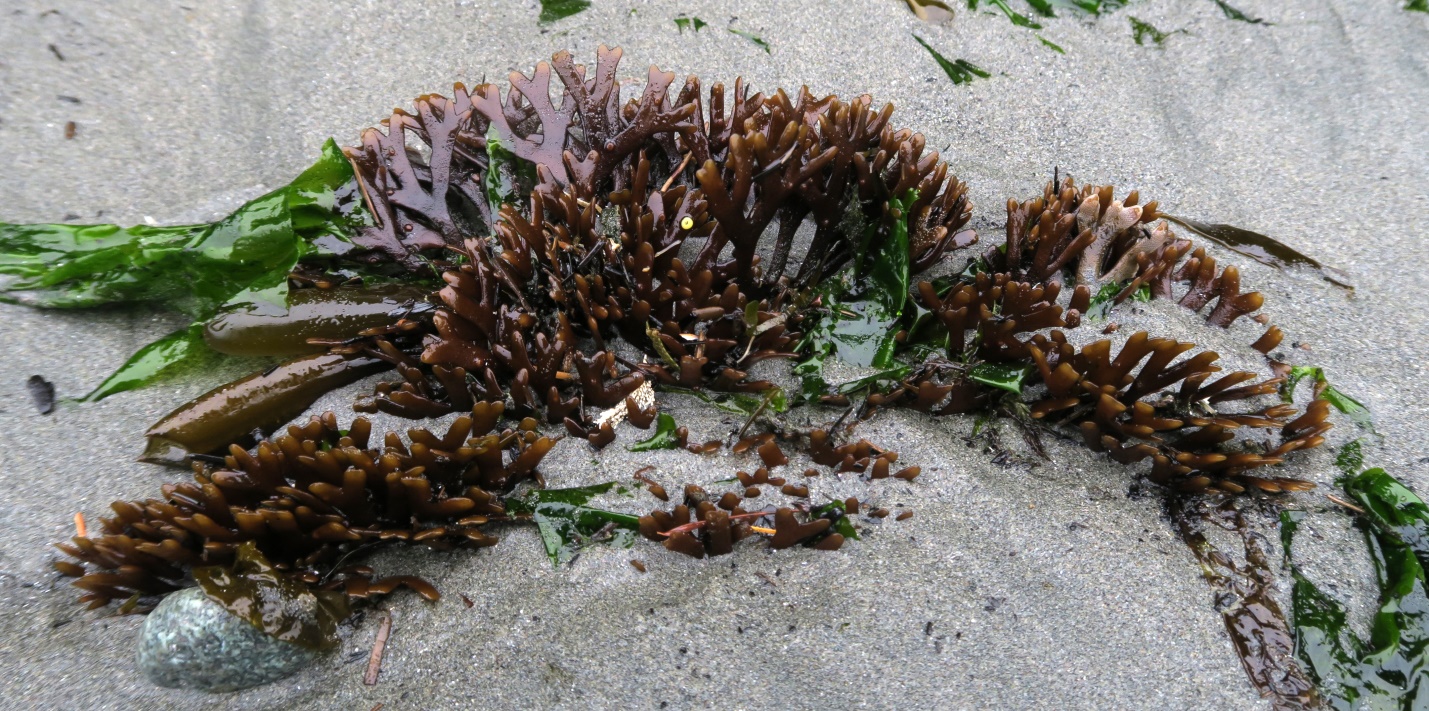
Figure 5: Ahnfeltiopsis linearis, a cluster of stems with varying lengths temporarily freed from the sand; Ulva sp. and Halosaccion glandiforme growing epiphytically; Fishboat Bay, Juan de Fuca Strait, BC, Canada. July 23, 2020. Photo ID: 27116 ©Seaweedwhisperings.com
Discussion:
The danger of “self-destructing” experienced in this seaweed energy was likened to how an electrical circuit is “blown”. There are three primary reasons an electrical circuit blows; overload, short circuit, ground fault.
Overload – circuit receives more amperage than it is intended to handle.
Short circuit – active wire and neutral wire touch, causing a large amount of current to flow and overload the circuit.
Ground fault – active wire makes contact with a ground wire or grounded area, causing flow of current and the live electrical parts are no longer protected from unintended contact.
The overload concept can be seen in this seaweed as being obsessive about a particular subject and being unable to process it as fast as the information’s coming in, so the overload occurs and the person “burns out”. That’s one type of overload.
Short circuit, this personality could go into a depression when passed over for a job that they’re well suited for – their flow is ‘short-circuited’ basically. They were sure the job was theirs and they cannot pour their energy into it.
Also, the stiff forked tips are like active wire and neutral wire – they must not touch each other; if this happens your path is destroyed. You’re flowing, then “zap!” Your aspirations are destroyed, short circuited again.
Relating to the concept of ground fault, communications from the Ahnfeltiopsis person can be received by others like “unintended contact” – and as such there is often misinterpretation with concepts seeming scattered and communication disorganized.
Both the problem and solution of this seaweed’s energy is related to its fantastic ability to take in what felt like infinite amounts of input, and its huge capability to process that input. It doesn’t give much out, however, because it’s always receiving, taking in and processing. So, the downside is it doesn’t share a lot; this is not often a deliberate withholding, simply the Ahnfeltiopsis personality is fully occupied with what’s going on/being processed within.
To the outsider the result is that they can’t get to know this person, their ideas, the concepts they might be discovering, what “makes this person tick”. The outsider sees just a little bit of them, the little bit that is exposed.
The upside and downside with this particular set of abilities is both limiting growth and potentially providing tools with which to grow.
This seaweed is so fascinated with processing… that it seems it’s stuck in learning and understanding, and may be underdeveloped in expressing and communicating. If it does communicate it can be rather tentative and unsure, it might not really want to share what it knows because it’s not certain that it’s right. Or, it’s very sure that it’s right but the topic is very new (or esoteric), so few others understand it anyway.
“Walked over/trod upon”…, (i.e. when hidden under the sand), this personality can easily be walked over. They might love to talk about their ‘subject’ but whoever they’re talking to just brushes them off often harshly, unjustly or even oppressively. Because of that, in a business setting or job, or even with interpersonal relationships, they are not easily ‘recognized’ and therefore are easily passed over for a promotion or intimate relationship. The job or contract or relationship is rewarded to someone more conventional, someone more easily ‘seen’.
The playfulness perceived in this seaweed is pure delight in exploration. This playful exploration feels as if it’s more concentrated with concepts and ideas rather than any physical manifestations. It’s also not play that is interacting with another person as such; rather, it’s often playing independently and very contentedly. The shadows cast with the headlamp onto the sand during our interaction are reminiscent of a bedtime game children sometimes play. Holding their hands close to a lamp and arranging and rearranging fingers to create “shadow animals” on the wall. This has the element of play and creation – to see what you can do yourself with the play of light. The paly doesn’t have long term consequence for this person; it’s ephemeral, gone with the shadow when the light is put out. It’s not consequential, such as playing a game with winners and losers.
This playful quality is one aspect of this seaweed’s energy that others could find themselves relating to. In a social setting this play is quite superficial, not representing the inner being of the Ahnfeltiopsis person accurately at all. It could show up if the person is forced to be out and interacting socially, such as reluctantly joining friends for dinner. The person then may opt to interact, rather than just sitting quietly all night, by tossing out a few playful comments. If they were back home (where they would often rather be) they wouldn’t be doing that; play there would be focused on the latest concepts they’re exploring and developing.
It may seem almost contradictory to state that while there is playfulness in this seaweed’s energy, it is more dominantly an energy that is lean, pared down to the minimum and purposeful. It does not serve this personality to indulge in frills or fancies – such things do not stand the test of functionality.
Stiffness was a strong concept in the Whispering. The physical reality for this seaweed is that much of it truly cannot move, it’s buried in sand. And the part of the seaweed that is visible, exposed to the world, chooses stiffness and flexibility to contend with external energies. Personality wise, the Ahnfeltiopsis energy can seem a bit stiff also, rigid, formal or offhanded – protecting again from outside energies. With relationships, it seems, this seaweed is averse to and avoids entanglement.
Leaving the seashore:
The ocean swell did subside as the in-situ observation progressed, but the tide continued to encroach. Time was running out and Person 2 knew she had more to write about interactions and going deeper with this seaweed. Person 1 asked her, “But do you need to be in the presence of the seaweed?” Person 2 thought for a movement and confidently replied, “No, it will be fine. I can connect with the energy remotely.” This proved to be true; is this ‘remote/distant connection’ specific to this seaweed, we wonder…?
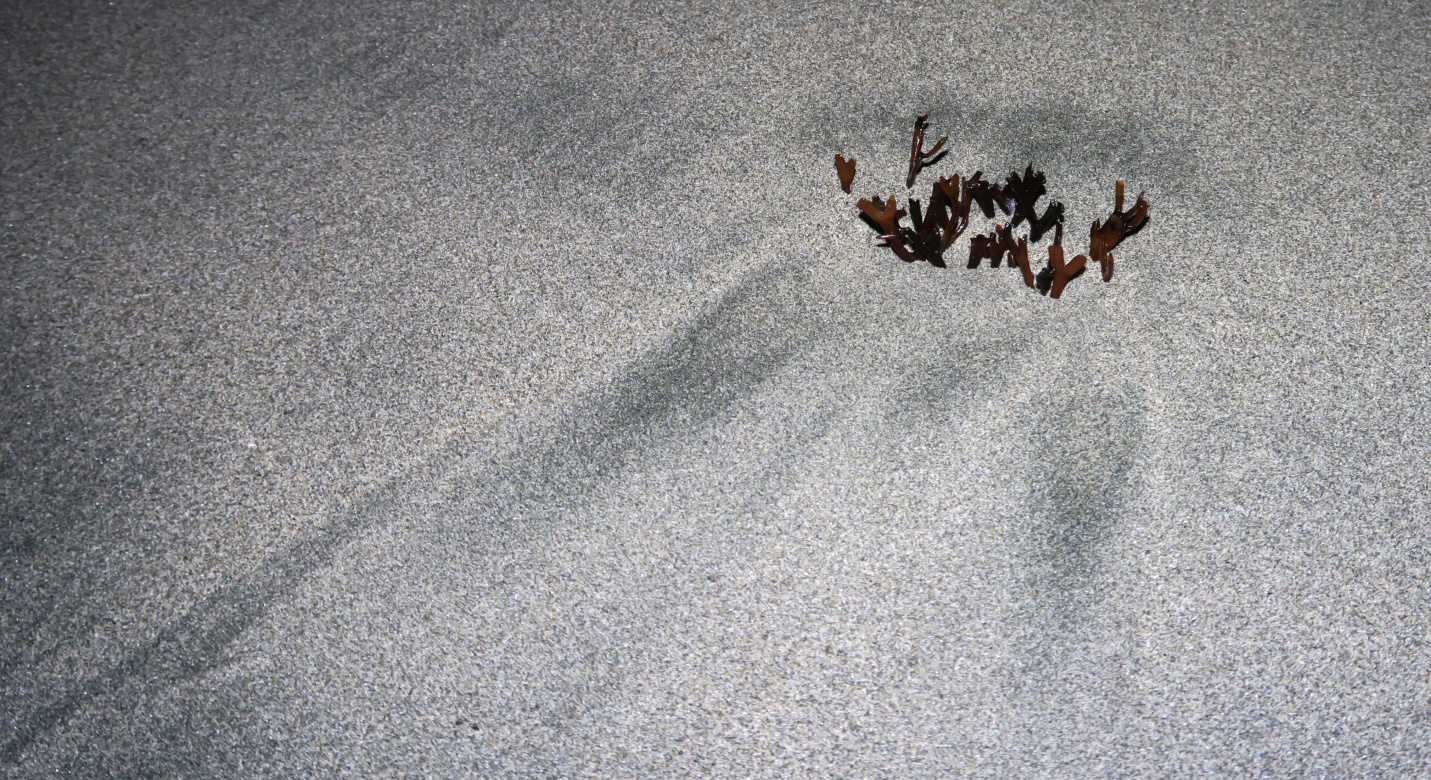
Figure 6: Ahnfeltiopsis linearis, a few fork-tips barely exposed by shifting sand; Fishboat Bay, Juan de Fuca Strait, BC, Canada. November 15, 2020. Photo ID: 27117 ©Seaweedwhisperings.com
Biology & Natural History Information:
Habitat:
Common on rocks (epilithic) of wave swept beaches, this alga associates with bedrock or boulders that are subjected to seasonal sand-burial (sand burial ranges between 1 to 3 meters). Mid to low intertidal, this seaweed is usually found in dense patches where a sandy beach joins a rocky habitat.
Pacific Coast Distribution:
Barkley Sound (Vancouver Island), British Columbia, to Point Conception, California.
Description:
A regularly dichotomously branched, brownish-maroon thallus, 10-18 cm tall, that is attached to the substrate via a red crust base. This red alga is tough and cartilaginous; its branches 5 – 8mm across, are cylindrical near the bottom of the thallus and become flattened after the first dichotomy. This is the largest, in terms of branch width, of the Ahnfeltia/Ahnfeltiopsis species.
Classification:
Phylum: Rhodophyta
Order: Gigartinales
Family: Phyllophoraceae
Genus: Ahnfeltiopsis
Species: Ahnfeltiopsis linearis (C.Agardh) P.C. Silva & DeCew 1992
Previous names: Sphaerococcus linearis C.Agardh 1817 and Gymnogongrus linearis (C.Agardh) J.Agardh 1851.
Other common names: Flattened Ahnfelt’s Seaweed
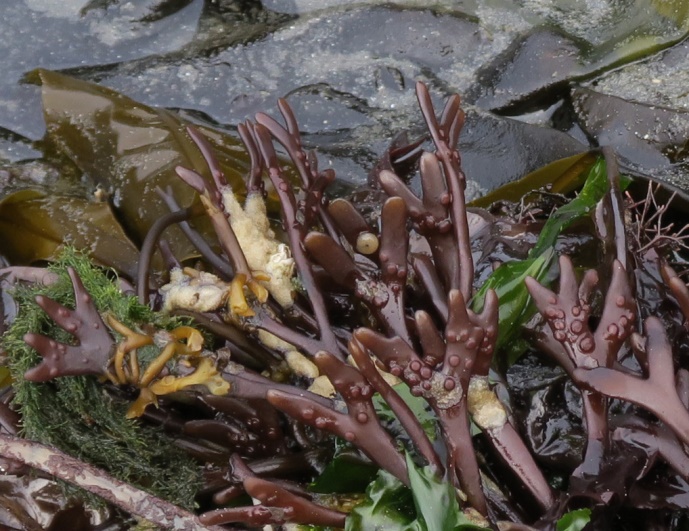
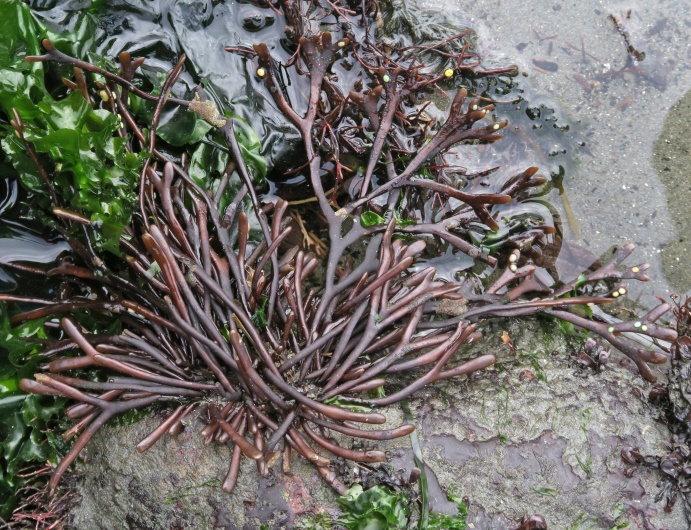
Figures 7 & 8:
Left: Ahnfeltiopsis linearis, cystocarpic stage (‘bumps’ visible on the stems here are the fruiting structure produced in red algae after fertilization); Fishboat Bay, Juan de Fuca Strait, BC, Canada. July 6, 2020. Photo ID: 27118 ©Seaweedwhisperings.com
Right: Ahnfeltiopsis linearis, whole plant exposed; full thalli and boulder anchor visible; Fishboat Bay, Juan de Fuca Strait, BC, Canada. June 8, 2020. Photo ID: 27119 ©Seaweedwhisperings.com
![]()